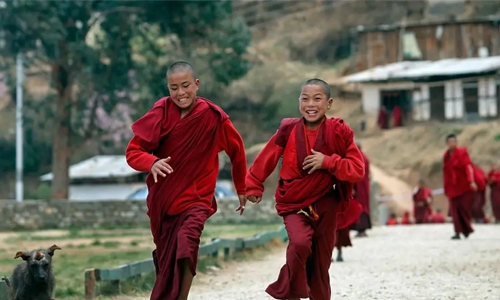The hard way to happiness in Bhutan
The Kingdom of Bhutan is perhaps best known for its credo of gross national happiness, or GNH, an official index of prosperity and quality of life in place of gross domestic product. GNH is based on four guiding pillars: good governance, sustainable socioeconomic development, environmental conservation, and the promotion and preservation of culture. Part of this philosophy champions a healthy, active lifestyle as a vehicle to help citizens maximise their pursuit of happiness.
Towards that end, in 2010, His Royal Highness Prince Jigyel Ugyen Wangchuck, president of the Bhutan Olympic Committee, started the Tour of the Dragon competition, billed as “the toughest one-day mountain bike race in the world.” Last fall, after a summer of hard, solitary, sometimes less-than-happy training, I went to Bhutan — nestled above the far northeast corner of India — to compete in the Dragon race.
The 167-mile course follows a chewed-up, menacing road under major construction while snaking its way over four mountain passes, three of which stand above 10,000 feet, all in one long, masochistic day with over 15,000 vertical feet of climbing. At 132 miles in, my system was fried and my GNH had plummeted, and I still had another 22 miles of steep, uphill pedalling in front of me, followed by a 13-mile descent. By comparison, one of the hardest stages of the 2019 Tour de France will cover just over 13,000 feet of climbing, and that’s on ultralight race bikes on fully paved roads.
The Dragon race’s course profile looks like an alarming EKG reading. I expected my body to protest. It began with a three-part barrage of cramps that surged across my lower limbs in paralysis of all forward progress: As I staggered up the steepest section of the whole course, a painful stab seized my right IT band while another twisted knots into my groin, followed by an aftershock rumbling across the left thigh for good measure. A fervent bicycle culture has seen rapid development in Bhutan.
Its northern border with Tibet runs along a treacherous seam of the Eastern Himalayan mountain range, which has historically protected the Switzerland-size country from outside influence and fortified it as one of the only nations in the world to never be colonised. This geographic and political isolation has long delayed Bhutan’s modernisation. The cycling culture has grown thanks to the bike-crazy former Druk Gyalpo, or Dragon King, who spends his days cruising trail networks throughout the mountains.
Bhutanese citizens idolise the royal family, often wearing lapel pins with the current king’s handsome side-burned portrait. “My goal has always been to create a world-class cycling event in Bhutan,” the prince said. “For someone who is a believer of healthy living, cycling is a very important sport to promote national happiness.” The roadside scenery alone was enough to warm the heart, with hydro-powered prayer wheels spinning beneath canopies of colourful prayer flags and wrinkled old women smiling toothless smiles as they shyly waved to passing cyclists.
The landscape is so lush and green (over 70 per cent of Bhutan is still covered in forest) that the hillsides explode with dense treetops resembling ripe heads of broccoli. It’s a constant collage of enchanted scenery. At 10 hours into the race — after a bleary-eyed 2 am start, a headlight dying prematurely in the dark, gravelly mud caked inside my eyelids and the onslaught of cramps as I pedalled through the upper end of a 50-degree temperature swing — I found it hard to smile. My achy legs felt like bags of concrete. My seizing lower back muscles were on the verge of snapping.
My neck and shoulders were so fatigued that I couldn’t even hold my head up to see where I was going. I had already doubled the distance of my longest training ride, and I was starting to look for a place to pull over and rest, or maybe just quit. The road banked into a left turn, and I slowly coasted through, gazing down at the pavement. Just then, I was hit with an eruption of cheers coming from 100 schoolchildren posted on the side of the road. Spectators across the entire country had lined the course to cheer for the riders while handing us bananas and chocolate.
It was the largest crowd of “cheering team” volunteers I’d yet to encounter, and their energy was colossal. In a sea of white khata scarves, the fanatic children chanted “Do your best! Do your best!” while running alongside me, clapping and screaming as if I were locked in a dead sprint. This unexpected surge of motivation from the children’s impassioned cheers and encouragement instantly revived my near lifeless body and spirit and jolted me into high gear. Although it had been hours since I had seen another cyclist, I was no longer alone.
The support cascaded down upon me until I burst into happy tears, something I’ve never experienced in team sports or recreational cycling. My pedal cadence quickened as my body lurched with a replenished energy. Several more cheering congregations propped me up along the rest of the ride. Infected with the stoke, I began passing other riders one by one, offering my own upbeat cheers and words of encouragement, which ultimately propelled me across the finish line in a decent 13 hours 45 minutes 24 seconds.
I’d cycled thousands of miles all summer in dreadful preparation of this ride, and while I had never felt so much pain in my training, I had never felt so much happiness, either.
Related Posts

